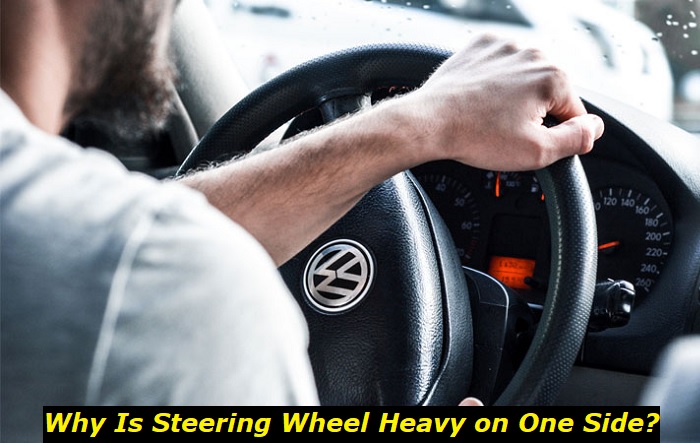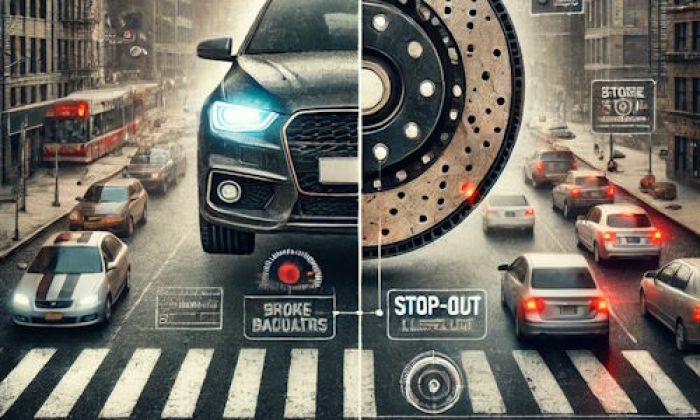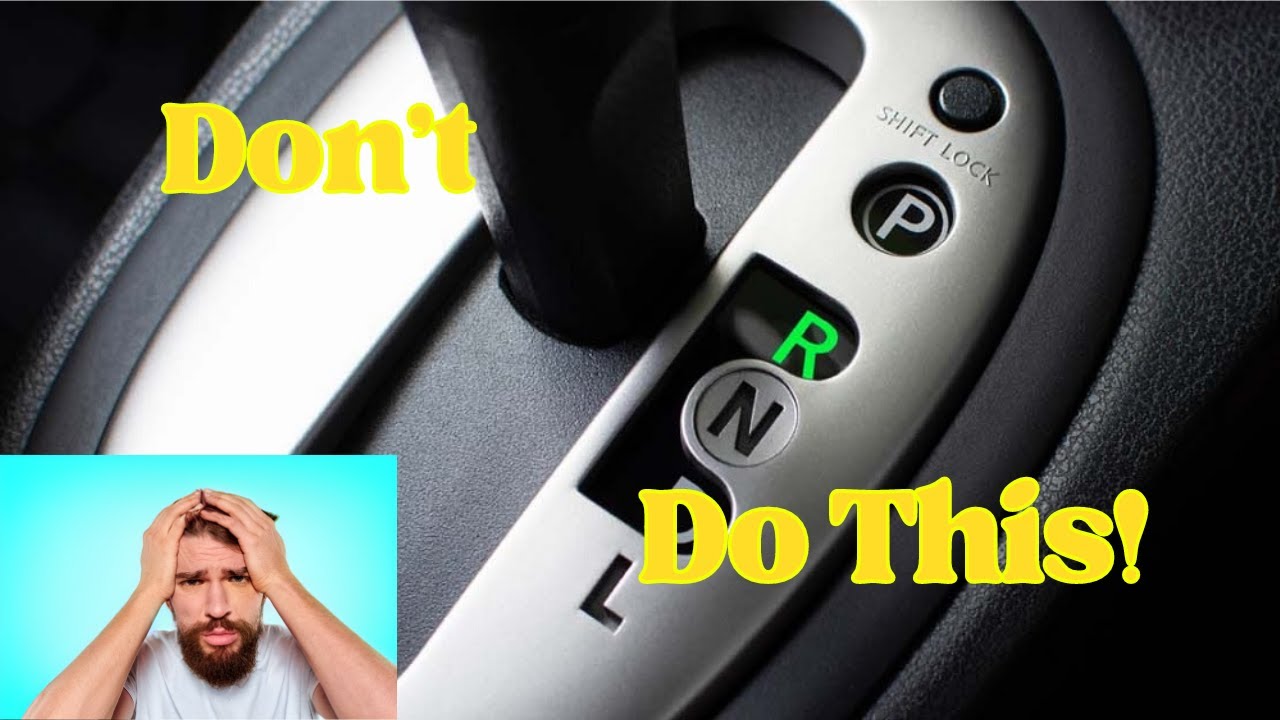The importance of a fully functioning car steering system is something that can't be overemphasized. As such, if you come across any issues with your steering system, be sure to visit an experienced mechanic as soon as you can.
In today's article, we are going to talk about a problem when the steering feels heavy on one side which means experiencing uneven steering system resistance from corner to corner. This can be a really serious issue, so be sure to stick around and find out what you can do to resolve it!

Steering Feels Heavy on One Side - What's Wrong?
There are a few potential causes of this issue such as low tire pressure on one side, misaligned wheels, a damaged or worn tire, power steering system issues, a faulty tie-rod, a worn-out steering rack, suspension issues, and brake system issues.
Today we'll focus on:
- What Causes the Steering to Feel Heavy on One Side?
- How to Fix Uneven Steering Weight?
- How To Prevent Steering System Issues?
- Is It Okay to Drive a Car with Uneven Steering Weight?
What Causes the Steering to Feel Heavy on One Side?
- Low Tire Pressure
- Tire Issues
- Wheel Alignment
- Steering System Problems (power steering issues, steering rack issues, faulty tie rod)
- Suspension Problems (issues with the struts, the shocks)
- Brakes System Issues (stuck/dragging brake caliper)
- Power Steering Fluid Issues
1) Low Tire Pressure
If one of your tires is underinflated, it is going to be more difficult to turn it, especially while driving at higher speeds. If you happen to have both of the tires on one side severely underinflated, you are going to have a hard time turning your steering wheel no matter the speed you are traveling at.
The best thing to do would be to take a reliable pressure gauge and check your tires one by one. Underinflation and overinflation can cause uneven tire wear which can also cause your steering wheel weight to become unbalanced.
2) Tire Issues
As mentioned previously, unevenly worn tires can cause your car to drift to one side or the other which also makes your steering weight unbalanced. Moreover, if your tire has bubbles on it or any flat spots, these can also cause your steering weight to become unbalanced.
3) Wheel Misalignment
One of the most common causes of uneven steering system weight is improper wheel alignment. The fact of the matter is that wheel misalignment causes your car to pull to one side or the other while making your steering wheel heavy on the opposite side. You can experience misaligned wheels after hitting a curb or after aggressively going over a pothole.
4) Steering System Problems
There are quite a few potential steering system problems that can cause uneven steering weight, the most common of which are power steering problems, steering rack issues, and worn-out tie rods.
If your power steering pump fails intermittently or is damaged, it can cause your steering to weigh up. Also, problems with your steering rack such as rack bushing wear, lack of lubrication, loose or worn tie rods, or internal damage can cause uneven steering weight.
5) Suspension System Problems
When it comes to suspension system problems, you can also find quite a few potential culprits here but the most common ones are worn-out or damaged struts and broken springs, both of which cause uneven weight distribution and thus affect the steering system quite a bit.
6) Brake System Problems
A dragging or stuck brake caliper on one side tends to cause the wheels on the side to brake even when you didn't engage the brakes. The effects of dragging or stuck brake calipers can be sometimes barely noticeable but they can also sometimes be really debilitating.
Higher-speed driving tends to accentuate this problem even further. So, if you feel your steering weight progressively worsen while accelerating, be sure to check your brake calipers.
7) Low Power Steering Fluid
Low-power steering fluid can cause uneven steering weight when the hydraulic fluid drops below a certain threshold and thus fails to assist in turning the steering wheel. This can reduce steering assistance to one side and increase overall friction which causes your steering system to intermittently weighted on one side or the other.
Moreover, your steering system can also become aerated when air finds its way into the power steering fluid lines.
How to Fix Uneven Steering Weight?
Well, it depends on what is causing it to become heavier. The best to do would be to first go ahead and inspect your tires, wheels, steering system, springs, shocks, brakes, and power steering fluid levels.
It would also be a good idea to go ahead and properly inflate your tires and make sure to align your wheels. When doing this, you should soon realize what is causing the problem, so make sure to follow these tips when trying to fix it all:
- Tire Issues - Unevenly worn, damaged, or scuffed tires should be replaced in order to eliminate uneven steering weight. If uneven tires are what's causing your steering system to become heavier, you should take your car in for a professional inspection as you don't your new tires to wear unevenly.
- Wheel Alignment - Fixing misaligned wheels means putting your car on an alignment machine and making sure your toe, camber, and caster are all precise. If you recently went over a bad pothole or you hit a curb, you should most definitely take your car for wheel alignment.
- Steering System Problems - If the problem is caused by power steering issues, it would be best to take your car to an experienced mechanic who will be able to tell you your best course of action. If it's just about worn-out components, replacing them would be the ideal solution.
- Suspension System Problems - Damaged and worn-out suspension components are a common cause of various steering system problems because these make the car's weight unevenly distributed. As such, it's always best to replace all the components that need replacing as this is the only true long-term solution.
- Brake System Issues - A stuck/dragging brake caliper is usually caused by caliper piston seizure, slide pin issues, damaged brake hoses, or warped rotors. Since your braking system is your main safety feature, always replace damaged/worn components when needed.
- Power Steering Fluid Issues - If your power steering fluid is low, you should first find out why it's low. If there is a leak, be sure to do an air test and find out where it is. Be sure to fix it, make your lines airtight, and refill your fluid. If the fluid is simply low, top it up to a proper level and make sure to get all the air out.
How To Prevent Steering System Issues?
Our cars are filled with loads of expendable parts which means that these will need replacing at some point. If you want these parts to last as long as they can, you need to perform regular inspections of your steering components, the rack, your tie rods, your steering column, and the rest of your suspension and steering system.
Wheel alignment is also something you need to do whenever your drivetrain suffers a significant impact such as going over an aggressive pothole, hitting the curb, or going over obstacles on the road. Tire maintenance includes tire rotation, tire balancing, and seasonal tire changes if you aren't using all-season tires.
Make sure to go gentle with your driving habits which means being easy with your inputs and always trying to avoid potholes and other obstacles on the road. Avoid overloading your car as excessive weight is going to strain parts of your steering and suspension system quite easily.
Make sure your power steering fluid is topped up, and always be sure to replace all of your worn-out parts with original parts. Lubricate all parts that need lubricating, and use your car for what it was intended to do.
Is It Okay to Drive a Car with Uneven Steering Weight?
It can be potentially dangerous to drive a car with uneven steering weight as it can cause safety hazards, uneven tire wear, or can further damage some of your car's essential systems.
The reality is that you should stop driving the car once you feel your steering weight is unbalanced until you find out what is exactly causing the problem. If the problem is due to misaligned wheels or slightly worn-out components, you can drive the car if you absolutely have to.
On the other hand, if a stuck brake caliper, low power steering fluid, or damaged tires are the reason, do not drive the car at all.
Conclusion
If your steering feels heavy on one side, it's best to check a few of the car's essential systems and parts such as the tires, the brakes, the suspension, the steering system, and power steering fluid levels. This will help you narrow down the reason why your steering feels heavy on one side.
To make the most out of your car, you need to follow pre-scheduled maintenance plans and always use original parts to make sure you never encounter unbalanced steering system weight.
About the authors
The CarAraC research team is composed of seasoned auto mechanics and automotive industry professionals, including individuals with advanced degrees and certifications in their field. Our team members boast prestigious credentials, reflecting their extensive knowledge and skills. These qualifications include: IMI: Institute of the Motor Industry, ASE-Certified Master Automobile Technicians; Coventry University, Graduate of MA in Automotive Journalism; Politecnico di Torino, Italy, MS Automotive Engineering; Ss. Cyril and Methodius University in Skopje, Mechanical University in Skopje; TOC Automotive College; DHA Suffa University, Department of Mechanical Engineering






Add comment